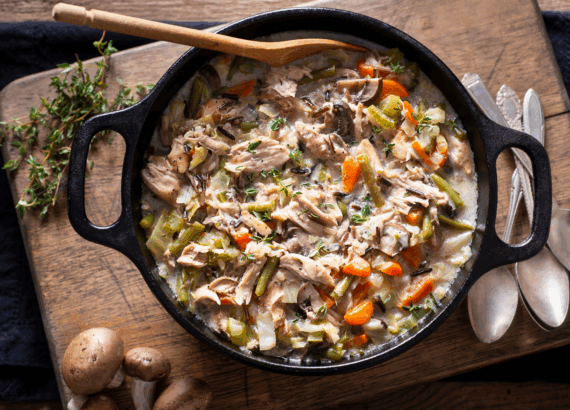Master Home Canning with These 8 Essential Tools
AmericanMom Team |
Because food security starts with what’s on your shelf—not theirs.
The grocery store shelves are a reminder we can’t ignore: supply chains break, prices soar, and the industrial food system isn’t as reliable as we’d like to believe. But there’s something deeply satisfying—and strategically smart—about opening your pantry in February to find rows of ruby-red tomato sauce, golden peach preserves, and crisp pickled vegetables that you put up yourself.
Whether you’re growing your own tomatoes or bulk-buying from a local farm stand, canning is a lost art every modern woman should reclaim. It’s not just about nostalgia or Instagram-worthy mason jars lined up on wooden shelves. It’s about taking control of your food supply, preserving peak-season flavors when produce is abundant and affordable, and ensuring your family has access to real, wholesome food no matter what’s happening in the world.
The beauty of canning lies in its simplicity: heat, seal, store. But like any craft worth doing, having the right tools transforms the experience from frustrating trial-and-error into something genuinely enjoyable. These 8 essentials make home canning not just possible, but simple, safe, and (dare we say?) deeply satisfying.
The Foundation: Understanding Why These Tools Matter
Before we dive into the specifics, it’s worth understanding that canning isn’t just about stuffing food into jars. It’s about creating an environment where harmful bacteria can’t survive while preserving the flavors and nutrients you worked so hard to grow or source. Each tool on this list serves a specific purpose in that process—from ensuring proper heat distribution to maintaining the precise measurements that keep your preserved foods safe to eat months down the line.
Modern canning builds on generations of wisdom while incorporating food safety knowledge that our great-grandmothers didn’t have access to. That means following tested recipes, maintaining proper temperatures, and using equipment designed for the job. It’s the difference between preserving food successfully and ending up with spoiled jars—or worse, foodborne illness.
1. Water Bath Canner (with Rack)
Why We Love It: This is your gateway drug to food preservation. Water bath canners work by submerging sealed jars in boiling water for a specific amount of time, creating the high-heat environment needed to destroy harmful microorganisms in high-acid foods like fruits, jams, jellies, pickles, and tomatoes.
The Deep Dive: Think of your water bath canner as a specialized pot with one job: maintaining consistent boiling temperatures while keeping your jars organized and accessible. The included rack lifts jars off the bottom of the pot (preventing them from rattling and potentially cracking) while ensuring water can circulate freely around each jar for even heating.
What makes this different from just using any large pot? The rack system and the canner’s depth. You need at least 1-2 inches of water covering your jar tops, plus additional space for the rolling boil that’s essential for proper processing. Most home stockpots simply aren’t deep enough.
Pro Tip: Look for enamel-coated canners rather than plain aluminum. They’re easier to clean, won’t react with acidic foods, and last for decades with proper care. The Granite Ware models are virtually identical to what your grandmother used—because some designs are simply timeless.
Where to Get It: Granite Ware Enamel Canner (Amazon)
Like Grandma’s—but you won’t have to scour eBay for it.
2. Wide-Mouth Mason Jars (With Lids)
Why We Love It: Wide-mouth jars are the workhorses of home canning. The broader opening makes them significantly easier to fill with chunky salsas, whole pickles, or thick preserves. They’re also easier to clean thoroughly—crucial for food safety—and stack more efficiently in your pantry.
The Deep Dive: Mason jars aren’t just containers; they’re precision-engineered preservation systems. The glass is designed to withstand rapid temperature changes without cracking. The two-piece lid system (flat lid plus ring) creates the vacuum seal that keeps your food safe while allowing you to test that seal by pressing the center of the lid.
Here’s what many beginners don’t realize: you’ll always need more jars than you think you will. That bumper crop of tomatoes? It’s going to fill more jars than seem mathematically possible. Buy cases, not individual jars, and consider it an investment in your food security infrastructure.
Size Strategy: Quart jars are perfect for tomato sauce, soup bases, and large batches of pickles. Pint jars work well for jams, jellies, and single-serving portions. Half-pint jars are ideal for gift-giving and testing new recipes.
Lid Logic: Always use new lids for each canning session. The rings can be reused indefinitely (as long as they’re not warped or rusted), but the flat lids have a sealing compound that only works once. It’s a small cost for food safety peace of mind.
Where to Get It: Ball Wide Mouth Quart Jars (Amazon)
Stock up—you’ll need more than you think.
3. Canning Funnel
Why We Love It: This isn’t just about keeping your kitchen clean (though it does that). A canning funnel ensures you maintain proper headspace—the crucial gap between your food and the jar lid that allows for expansion during processing and proper seal formation.
The Deep Dive: Headspace matters more than you might think. Too little, and your jars may not seal properly or could even explode from pressure buildup. Too much, and you risk food discoloration and poor vacuum formation. A quality canning funnel is designed with the right diameter to fit snugly into jar mouths while leaving you room to fill accurately.
Beyond measurements, a funnel dramatically reduces the mess factor that can make new canners want to give up. There’s nothing more frustrating than spending hours preparing a beautiful batch of strawberry jam only to have half of it end up on your jar rims and countertops.
Material Matters: Stainless steel funnels are worth the extra cost. They won’t absorb odors or stains, can handle boiling-hot foods without warping, and will literally last a lifetime. Plastic funnels work, but they’ll eventually crack or melt.
Where to Get It: Norpro Stainless Steel Funnel (Amazon)
No sticky rims. No wasted jam.
4. Jar Lifter Tongs
Why We Love It: These specialized tongs are designed specifically for gripping hot, wet glass jars safely. Regular kitchen tongs will slip, drop jars, or crack the glass. Jar lifters have rubber-coated grips that hold securely even when everything is hot and steamy.
The Deep Dive: Canning involves handling jars at temperatures that will absolutely burn you. We’re talking about lifting glass containers filled with boiling liquid out of a pot of vigorously boiling water. This isn’t a job for makeshift tools or brave fingers.
Quality jar lifters have a specific curve and grip pattern designed to cradle the neck of a mason jar securely. They’re long enough to keep your hands safely away from steam and splashing water, and the gripping surface won’t slip even when wet.
Safety First: Beyond preventing burns, proper jar lifters reduce the risk of dropping and breaking jars full of your hard work. They also help you move jars smoothly to cooling areas without jarring them (pun intended), which could interfere with proper seal formation.
Where to Get It: Ball Secure-Grip Jar Lifter (Amazon)
Because we’re not pioneers or pyros.
5. Canning Labels (Dissolvable!)
Why We Love It: Six months from now, that jar of mysterious red sauce isn’t going to identify itself. Dissolvable labels solve the eternal canning problem: knowing what you preserved and when, without dealing with sticky residue that makes jar reuse a nightmare.
The Deep Dive: Proper labeling isn’t just about organization—it’s about food safety. You need to track not just what’s in each jar, but when you canned it and what recipe you used. Different recipes have different storage lives, and you want to use older stock first to maintain quality.
Traditional labels leave adhesive residue that’s nearly impossible to remove completely. That residue can interfere with proper jar sealing in future canning sessions and makes your jars look unprofessional if you’re giving them as gifts.
Dissolvable labels solve this perfectly. They stick securely during storage but dissolve completely in warm, soapy water when you’re ready to reuse the jars. No scraping, no goo, no frustration.
Labeling Strategy: Include the contents, date canned, and recipe source. For example: “Tomato Sauce – Sept 2024 – Ball Blue Book p.89”. This level of detail helps you track which recipes work best and ensures you’re using tested, safe formulations.
Where to Get It: Dissolvable Canning Labels (Amazon)
Write it, wash it, reuse it.
6. Bubble Remover / Headspace Tool
Why We Love It: Air bubbles trapped in your jars aren’t just cosmetic issues—they can prevent proper heat penetration during processing and create pockets where harmful bacteria could survive. This simple tool eliminates that risk while helping you measure proper headspace.
The Deep Dive: When you fill jars with thick sauces, chunky salsas, or layered preserves, air bubbles inevitably get trapped. These bubbles can expand during processing, potentially breaking your jars or preventing proper seals from forming. More seriously, they can create areas where the food doesn’t reach proper temperatures for safe preservation.
A bubble remover—essentially a thin, flat wand—allows you to slide down the sides of filled jars to release trapped air while disturbing the food as little as possible. Many models also include measurement marks for checking headspace, making this tool doubly useful.
Technique Tip: Insert the bubble remover straight down, then gently move it around the perimeter of the jar. You’ll see bubbles rise to the surface. Add more food if needed to maintain proper headspace after removing bubbles.
Where to Get It: Ball Bubble Remover & Headspace Tool (Amazon)
A small tool with a big job.
7. Canning Cookbook or Guide
Why We Love It: Home canning isn’t the place for improvisation. Successful preservation requires following tested recipes that ensure proper acidity levels, processing times, and safety protocols. A good canning guide is your insurance against both failure and foodborne illness.
The Deep Dive: The science of food preservation is more complex than it appears. Factors like pH levels, food density, jar size, and processing time all interact to create safe, shelf-stable products. Change one variable—say, reducing sugar in a jam recipe or adding extra vegetables to salsa—and you could create conditions where dangerous bacteria like botulism can thrive.
This is why experienced canners swear by tested recipes from trusted sources like the Ball Blue Book, the USDA Complete Guide to Home Canning, or university extension publications. These recipes have been laboratory-tested to ensure safety while maintaining quality.
Beyond Safety: A good canning guide also teaches you the why behind the techniques, helps you troubleshoot problems (why didn’t my jars seal?), and provides the confidence that comes from understanding the process rather than just following steps blindly.
Recipe Adaptation: Once you understand the principles, you can make small modifications safely—but always within guidelines. Want spicier salsa? Add more hot peppers. But don’t reduce the vinegar or change the vegetable ratios without consulting tested variations.
Where to Get It: Ball Blue Book Guide to Preserving (Amazon)
Your canning bible.
8. Canning Kit (Starter Bundle)
Why We Love It: If you’re starting from scratch, a complete kit eliminates the guesswork of selecting individual tools while often saving money compared to buying items separately. Look for kits that include the essentials: jar lifter, funnel, bubble remover, lid lifter, and measuring tools.
The Deep Dive: Quality starter kits typically include 5-7 essential tools in a convenient storage container. Beyond the basic tools, many include useful extras like a magnetic lid lifter (for plucking lids from hot water without contaminating them) and a plastic headspace ruler.
The main advantage of a kit is convenience—you get everything you need to start canning in one purchase. The potential downside is that some kit tools might not be as high-quality as what you’d choose individually, but for beginners, this represents excellent value and gets you started immediately.
Kit vs. Individual: If you’re sure you want to can long-term, consider buying higher-quality individual tools. If you’re testing the waters or want to gift someone a complete starter set, a kit is perfect.
Storage Bonus: Most kits come with a storage container that keeps all your canning tools organized and accessible. This might seem like a small thing, but having everything in one place makes the difference between canning regularly and letting your equipment gather dust in various kitchen drawers.
Where to Get It: 5-Piece Canning Tool Kit (Amazon)
Buy once, preserve forever.
Beyond the Basics: Setting Yourself Up for Canning Success
Having the right tools is just the beginning. Successful home canning also requires understanding a few key principles:
Start Small: Your first canning session shouldn’t be a 40-pound tomato marathon. Try a simple recipe like strawberry jam or bread-and-butter pickles to get comfortable with the process and your equipment.
Timing Matters: Plan your canning sessions when you have uninterrupted time and energy. Rushed canning leads to mistakes, and mistakes in food preservation can have serious consequences.
Source Quality: Great preserved foods start with great fresh ingredients. The canning process can’t improve poor-quality produce—it can only preserve what’s already there.
Follow the Recipe: This bears repeating because it’s so important. Tested canning recipes aren’t suggestions—they’re formulas for safety. Save your creativity for recipes that don’t rely on precise preservation science.
Test Your Seals: After jars have cooled completely (12-24 hours), test the seal by pressing the center of each lid. It should be firm and not move. Any jars that didn’t seal properly should be refrigerated and used within a few days.
The Bigger Picture: Why Canning Matters Now More Than Ever
In an era of supply chain disruptions, inflation, and increasing awareness of industrial food processing, home canning represents something powerful: control over your family’s food supply. When you can your own produce, you know exactly what’s in those jars. No mysterious additives, no concerns about recalls, no wondering about the nutritional quality of processed foods.
But beyond food security, there’s something deeply satisfying about connecting with the rhythms of seasonal eating and preservation. There’s pride in opening a jar of peach preserves in January that captures the essence of summer’s abundance. There’s joy in giving homemade gifts that represent hours of love and labor.
Most importantly, canning is a skill that, once learned, serves you for life. Economic conditions change, supply chains fail, but the knowledge of how to preserve food safely remains valuable regardless of circumstances.
🍅 Freedom Tastes Homemade
When store shelves go empty, your pantry doesn’t have to. Stock it with love, labor, and a little steam. Every jar you fill is a small declaration of independence—from industrial food systems, from supply chain vulnerabilities, from the assumption that someone else should be responsible for feeding your family.
The investment in these eight tools pays dividends in food security, cost savings, and the simple pleasure of eating well from your own stores. More than that, you’re reclaiming an essential life skill and connecting with generations of wisdom about feeding families well.
Your great-grandmother would recognize every tool on this list and approve of your choice to take control of your food supply. The only difference is that now you have access to better safety information and more reliable equipment. The satisfaction, the security, and the flavor? Those remain exactly the same.
Start with these essentials, follow tested recipes, and discover why home canning has sustained families through every crisis for generations. Your future self—and your family—will thank you.






